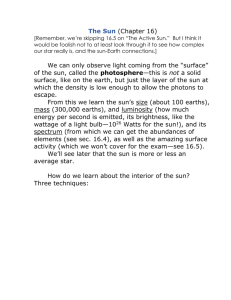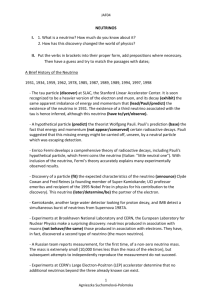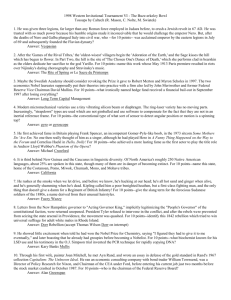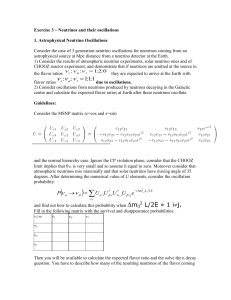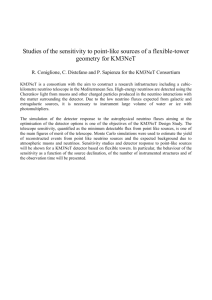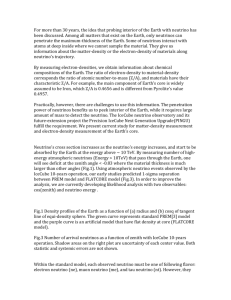Experimental Neutrino Physics in Brazil Experimental Neutrino
advertisement
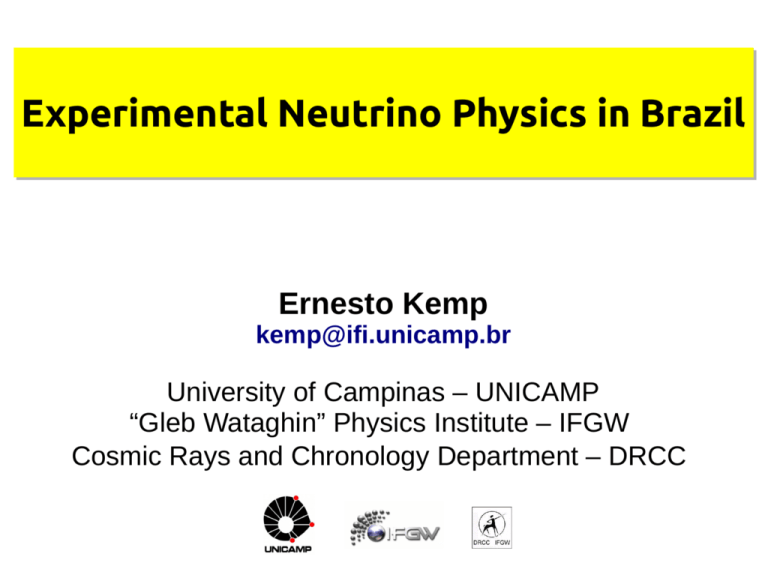
Experimental Neutrino Physics in Brazil Ernesto Kemp kemp@ifi.unicamp.br University of Campinas – UNICAMP “Gleb Wataghin” Physics Institute – IFGW Cosmic Rays and Chronology Department – DRCC Outline ● Physics Challenges ● ● ● The context of neutrino experiments in the frontier of Physics Experiments ● ● History and facts Where are the Brazilians researchers/institutions within this scenario ? Conclusion 11/05/15 UC-Davis FAPESP Week 2 History: the beta decay puzzle 11/05/15 Expected beta-particle energy Neutrinos were born in 1930, when Wolfgang PAULI tried a saving operation of "the energy conservation principle" The famous Pauli's letter for radioactive ladies and gentlemen can be found at: http://lappweb.in2p3.fr/neutrinos/aplettre.html Control room at Savannah River reactor Original papers on neutrino first detection: •"Detection of the Free Neutrino: A Confirmation", C. L. Cowan, Jr., F. Reines, F. B. Harrison, H. W. Kruse and A. D. McGuire, Science 124, 103 (1956). •"The Neutrino", Frederick Reines and Clyde L. Cowan, Jr., Nature 178, 446 (1956). UC-Davis FAPESP Week 3 Neutrino: a building block 11/05/15 UC-Davis FAPESP Week 4 Neutrinos: some facts ● Neutrinos are super abundant. Neutrinos are the second most abundant particle in the universe. ● ● ● ● The nuclear fusion reactions in the Sun sends 65 billion neutrinos per second per square centimeter to Earth, they are crossing us all the time. Neutrinos are almost massless. The three types of neutrinos in the standard model are the lightest particles with a non-zero mass ever discovered. The upper limit on the mass of the heaviest neutrino is still more than 4 million times lighter than the electron, the next lightest particle. Neutrinos may have altered the course of the universe. Why we have predominance of matter over antimatter? Cosmologists think that at the start of the universe there were equal parts of matter and antimatter. ● ● If we were to take a snapshot, we’d see that every cubic centimeter has approximately 1,000 photons and 300 neutrinos. Neutrino interactions may have tipped this delicate balance, enabling the formation of galaxies, stars and planets like our own Earth. Neutrinos are the key particle in the heavy-element forges of the universe: neutrinos dissipate more than 99 percent of a supernova’s energy. Supernovae eject heavy elements to the cosmos in a recycling matter mechanism. ● “Core collapse” supernovae end as either a black hole or a neutron star. Neutrinos are key particles to understand how supernovae explode and tell us more about other astronomical objects like active galactic nuclei. Do they deserve a careful and comprehensive study ??? 11/05/15 UC-Davis FAPESP Week 5 Neutrinos: historical remark 11/05/15 UC-Davis FAPESP Week 6 Physics Challenges 11/05/15 http://science.energy.gov/~/media/hep/pdf/ files/pdfs/p5_report_06022008.pdf UC-Davis FAPESP Week 7 Physics Challenges: P5 report (2008) ● The Intensity Frontier ● ● “Measurements of the mass and other properties of neutrinos are fundamental to understanding physics beyond the Standard Model and have profound consequences for the understanding of the evolution of the universe.” (PG. 3) “Recent striking discoveries make the study of the properties of neutrinos a vitally important area of research. Measurements of the properties of neutrinos are fundamental to understanding physics beyond the Standard Model and have profound consequences for the evolution of the universe. The latest developments in accelerator and detector technology make possible promising new scientific opportunities in neutrino science as well as in experiments to measure rare processes.” (PG. 10) The panel recommends a world-class neutrino program as a core component of the US program (PG. 3) 11/05/15 UC-Davis FAPESP Week 8 Physics Challenges: P5 report (2014) 11/05/15 UC-Davis FAPESP Week 9 Physics Challenges: scientific motivations ● ● Neutrino Physics is one of the most active field in the advanced frontier of “Big Science” Offers an unique opportunity to stay tuned with technological and scientific progress in worldwide scale ● 11/05/15 For sure Brazilian scientists have interest in be part of it. UC-Davis FAPESP Week 10 Figures about BR-HEP 11/05/15 ● 37.5 % ● ~ 100 Institutes ~ 600 faculty Field Theory Cosmology & Gravitation other 6.7 % 17.8 % Nuclear 2.4 % Astrop. Phenomenology HEP-exp 5.2 % 17.2 % 13.1 % UC-Davis FAPESP Week 11 Figures about BR-HEP: by subarea ● hep-exp ● Particle Physics Field Theory ● 5800 papers ● 3900 papers ● 6800 papers ● 242 technological products 218 technological products ● ● 375 technological products ● ● 211 supervision works in progress ● 1080 concluded ● ● ● 259 supervision works in progress 1379 concluded ● ● 534 supervision works in progress 3476 concluded cosmology ● 3000 papers ● 308 technological products ● ● 318 supervision works in progress 1352 concluded 11/05/15 UC-Davis FAPESP Week ● Lattes data base (from CNPq) ● Sampled from ENFPC (2013) ● Caution: there are “ contaminations” 12 Neutrino experiments: some examples 11/05/15 UC-Davis FAPESP Week Imagem artística de SN2006gy - NASA 13 Where ? : Experiments with BR teams ● Neutrino Properties: ● oscillations – – – – DUNE Double Chooz NOvA MINOS ● ● MINOS+ Neutrino Interactions: ● 11/05/15 ● nuclear scattering and NSI – – – ● Astrophysical Neutrinos – DUNE – LVD – Pierre Auger Observatory Neutrino Applied Physics – Neutrinos-ANGRA DUNE MINERVA CONNIE UC-Davis FAPESP Week 14 Where ? : Experiments with BR teams ● Neutrino Properties: ● oscillations – – – – DUNE Double Chooz NOvA MINOS ● ● MINOS+ Neutrino Interactions: ● 11/05/15 ● nuclear scattering and NSI – – – DUNE MINERVA CONNIE UC-Davis FAPESP Week ● Astrophysical Neutrinos – DUNE – LVD – Pierre Auger Observatory Neutrino Applied Physics – Neutrinos-ANGRA Most of Brazilian neutrino scientists have joined DUNE collaboration: 1) a more efficient participation 2) a very attractive experiment 15 What ? : activities from BR teams ● R&D – ● Experiment construction – ● Detectors development, integration, prototype tests installation, commissioning Monitoring – Data analysis for detector characterization ● performance and systematics studies ● Data Analysis ● Management 11/05/15 – – Scientific boards and task leading Administrative boards and tasks UC-Davis FAPESP Week 16 Experiments: Double Chooz 11/05/15 UC-Davis FAPESP Week 17 Experiments: Double Chooz 11/05/15 UC-Davis FAPESP Week 18 Experiments: Double Chooz 11/05/15 UC-Davis FAPESP Week 19 Experiments: MINOS 11/05/15 UC-Davis FAPESP Week 20 Experiments: MINOS 11/05/15 The detectors are made of steel plates interleaved with scintillators ● We identify the neutrinos through the trajectory of the particles they generate ● The number of muon neutrinos measured in the detector is far less than expected based on the near detector if there was no oscillation ● UC-Davis FAPESP Week 21 Experiments: MINERVA 11/05/15 UC-Davis FAPESP Week 22 Experiments: MINERVA 11/05/15 UC-Davis FAPESP Week 23 Experiments: MINERVA 11/05/15 UC-Davis FAPESP Week 24 Experiments: Large Volume Detector - LVD 11/05/15 UC-Davis FAPESP Week 25 Experiments: Large Volume Detector - LVD 11/05/15 UC-Davis FAPESP Week 26 Experiments: Large Volume Detector - LVD 11/05/15 UC-Davis FAPESP Week 27 Experiments: Large Volume Detector - LVD 11/05/15 UC-Davis FAPESP Week 28 Experiments: Pierre Auger Observatory 11/05/15 UC-Davis FAPESP Week 29 Experiments: Pierre Auger Observatory 11/05/15 UC-Davis FAPESP Week 30 Experiments: Pierre Auger Observatory 11/05/15 UC-Davis FAPESP Week 31 Experiments: Pierre Auger Observatory 11/05/15 UC-Davis FAPESP Week 32 Experiments: Pierre Auger Observatory 11/05/15 UC-Davis FAPESP Week 33 Experiments: Pierre Auger Observatory 11/05/15 UC-Davis FAPESP Week 34 Experiments: Neutrinos-ANGRA 11/05/15 Development of new techniques for nuclear reactor monitoring UC-Davis FAPESP Week 35 Experiments: Neutrinos-ANGRA 11/05/15 World map of nuclear reactors UC-Davis FAPESP Week 36 Experiments: Neutrinos-ANGRA 11/05/15 UC-Davis FAPESP Week 37 Experiments: Neutrinos-ANGRA 11/05/15 UC-Davis FAPESP Week 38 Experiments: Neutrinos-ANGRA 11/05/15 UC-Davis FAPESP Week 39 11/05/15 UC-Davis FAPESP Week 40 Experiments: DUNE design 11/05/15 UC-Davis FAPESP Week 41 Experiments: DUNE design 11/05/15 UC-Davis FAPESP Week 42 DUNE: current efforts ● Hardware development ● Light collectors based on dopped fibers – ● (DRCC + Special Fibers Lab) Simulations: – – Light propagation and light collections efficiency Calculations on detector sensitivity ● ● 11/05/15 Supernovae, non-standard interactions, quantum effects Unicamp + UFABC + UFAL + UFG + UESB UC-Davis FAPESP Week 43 Conclusions ● ● ● Brazilian experimentalists on neutrino science are well inserted There are many opportunities both for new collaborators and students Future is also promising Thank you ! 11/05/15 UC-Davis FAPESP Week 44 11/05/15 BACKUP SLIDES UC-Davis FAPESP Week 45 Physics Challenges ● The Intensity Frontier ● ● “Measurements of the mass and other properties of neutrinos are fundamental to understanding physics beyond the Standard Model and have profound consequences for the understanding of the evolution of the universe.” (PG. 3) “Recent striking discoveries make the study of the properties of neutrinos a vitally important area of research. Measurements of the properties of neutrinos are fundamental to understanding physics beyond the Standard Model and have profound consequences for the evolution of the universe. The latest developments in accelerator and detector technology make possible promising new scientific opportunities in neutrino science as well as in experiments to measure rare processes.” (PG. 10) The panel recommends a world-class neutrino program as a core component of the US program (PG. 3) 11/05/15 UC-Davis FAPESP Week 46 Physics Challenges 3 . 2 The Intensity Frontier : Neutrino Physics and Precision Measurements At the Intensity Frontier, precision measurements of the properties of leptons and quarks can lead the way to resolving some of the universe’s deepest mysteries. ● 3 . 2 . 1 Neutrino physics Neutrino physics has had a long and distinguished history, … We outline an ambitious vision that builds on that strong scientific tradition to capture the unique scientific opportunities of neutrino science. Results of recent experiments have revolutionized and brought renewed excitement to this field. ● They have shown that neutrinos have nonzero masses, mix with one another, and oscillate among the neutrino flavor states. Cosmology tells us that the neutrino masses are very small, less than one millionth of the electron’s mass. Oscillation studies find tiny nonzero neutrino mass differences between generations, but large values of two of the three mixing angles, θ23 ~ 45o and θ12 ~ 32o . Currently we only have an upper limit of about 10 o on the third angle, θ13. Collectively, these advances in neutrino physics have opened the first crack in the Standard Model of particle physics. They have significantly changed our view of neutrinos and the special role they play in elementary particle physics, astrophysics and cosmology. In the coming years, neutrino physics presents exciting opportunities: ● the measurement of the mixing angle between the heaviest and lightest neutrinos, ● determination of the hierarchy of neutrino masses, ● the search for matter-antimatter asymmetry (CP violation) in neutrino mixing, and lepton number violation. These opportunities are fundamental to the science of particle physics and have profound consequences for the understanding of the evolution of the universe. 11/05/15 UC-Davis FAPESP Week 47 Physics Challenges ● Questions for the future 1) Do neutrino oscillations violate CP? ● ● ● CP violation drive a matter-antimatter asymmetry (leptogenesis)? What is the value of the CP violating phase ? CP violation among neutrinos related to CP violation in the quark sector? 2) What are the relative masses of the three known neutrinos? ● ● ● Are they “normal,” (m3>m2>m1) or “inverted” hierarchy (m2>m1>m3)? The ordering has important consequences for interpreting the results of neutrinoless double beta decay origin and pattern of masses in a more fundamental way 3) Is θ23 maximal (45o)? if so, why? ● ● Will the pattern of neutrino mixing provide insights regarding unification of the fundamental forces? Will it indicate new symmetries or new selection rules? 4) Are neutrinos their own antiparticles? ● ● lepton number violation, or leptogenesis, in the early universe? Observable : neutrinoless double beta decay in nuclei 5) What can we learn from supernovae neutrinos? ● Can we observe the neutrino remnants of all supernovae that have occurred since the beginning of time? 6) What can neutrinos tell us about new physics? beyond the Standard Model, dark energy, extra dimensions? Do sterile neutrinos exist? Who ? : the Brazilian neutrino community ● Among these people there are those interested in neutrinos (obs.: only main research interest, not accounted researchers working occasionally with neutrinos) ● ● 24 (faculty) = 13 (exp) + 11 (theo) 11 Institutions (number of people): ● UNICAMP (4), USP (2), UFABC (3), IFT (2) (SP state) ● UFG (1) (GO state) ● CBPF (3), UFRJ (1) , PUC-Rio (1) (RJ state) ● UFAL (1), UFJF (1) (MG state) ● UFBA (2), UEFS (1) (BA state) ● UFPR (1) (PR state) ● UFPB (1) (PB state) 11/05/15 UC-Davis FAPESP Week 49 Who ?: countries ● Latin American Countries in neutrino experiments ● Argentina : Auger,CONNIE, ANDES ● Brazil: LBNE, DC, Auger, MINOS(+), NOvA, CONNIE, NuANGRA, ANDES ● Chile: ANDES ● Colombia: NEXT ● Paraguay: CONNIE ● Peru: MINERvA ● Mexico: Auger, MINERvA, ANDES 11/05/15 UC-Davis FAPESP Week 50 Experiments: MINOS 11/05/15 UC-Davis FAPESP Week 51


